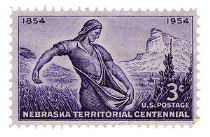Extension, Cooperative

Nebraska Agricultural Experiment Station: Historical Research Bulletins
Date of this Version
10-1943
Document Type
Article
Citation
Hathaway, I.L., Trimberger, G.W. and Davis, H.P. (1943) The use of dried whey and blood meal in the raising of calves on limited amounts of milk (Research Bulletin: Bulletin of the Agricultural Experiment Station of Nebraska No. 132)
Abstract
The use of substitutes for milk in the raising of calves is always of interest to the progressive dairyman, since there are a number of circumstances in which it is advantageous to reduce the milk feeding period. Producers of market milk often desire to raise their calves on as little milk as possible in order to have more milk available for market. When the demand for milk is good, dairymen who usually market cream only may prefer to sell milk and raise their calves on starters or other milk substitutes. Dairy farmers may wish to use the skim milk generally allowed the calves to replace a part of the protein concentrates used in swine and poultry production when these feeds become scarce or too high in price. In times of labor shortage, dairymen are especially interested in labor-saving methods, and usually methods which substitute dry feeds for liquid milk result in a saving of labor. When there is a scarcity of milk for human food, it may be desirable to raise dairy calves with as little milk as is practicable. Therefore, while there is normally an interest in methods of raising calves on limited amounts of milk, this interest often becomes acute in time of war scarcities. As a result of renewed interest in milk substitutes for calf feeding, this study was instigated--to determine the value of dried whey as a means of saving milk in the raising of calves, to demonstrate that calves can be raised with a limited amount of labor, and to find an additional use for whey, much of which is wasted annually.
Included in
Agriculture Commons, Dairy Science Commons, Nutrition Commons


Comments
ISSN 0097-1463